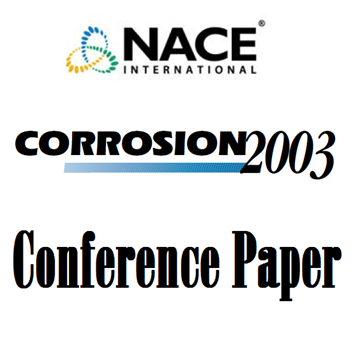Search
Water/Wastewater
View as
Sort by
Display
per page
00584 TAMPA ELECTRIC COMPANY BIG BEND STATION: SYSTEM DESIGN, MAT'L SELECTION AND CONSTRUCTION OF UNITS 1 AND 2 WET FGD SYSTEM
Product Number:
51300-00584-SG
ISBN:
00584 2000 CP
$20.00
00825 CORROSION OF INFRASTRUCTURE WITHIN MADINAT YANBU AL-SINAIYAH, SAUDI ARABIA
Product Number:
51300-00825-SG
ISBN:
00825 2000 CP
$20.00
01414 ADVANCES IN MATERIALS FOR SODIUM HYPOCHLORITE SERVICE
Product Number:
51300-01414-SG
ISBN:
01414 2001 CCP
$20.00
02446 MICROBIOLOGICALLY INFLUENCED CORROSION FAILURE ANALYSIS OF 304L STAINLESS STEEL PIPING SYSTEM LEFT STAGNANT AFTER HYDROTESTING WITH CITY WATER
Product Number:
51300-02446-SG
ISBN:
02446 2002 CP
Publication Date:
2002
$20.00
02451 MIC ON STAINLESS STEELS IN WASTEWATER TREATMENT PLANTS FIELD TESTS AND A RISK ASSESSMENT
Product Number:
51300-02451-SG
ISBN:
02451 2002 CP
$20.00
03056 Zero (VOC) Structural Epoxy Rehabilitation of Steel and Concrete Tanks, Pipes and Structures
Product Number:
51300-03056-SG
ISBN:
03056 2003 CP
$20.00
03058 100% Solids Tank Lining Systems Extended Coating Life Equals Dollars Saved
Product Number:
51300-03058-SG
ISBN:
03058 2003 CP
Publication Date:
2003
$20.00
03060 HYDROGEN SULFIDE AND MICROBIOLOGICALLY INFLUENCED CORROSION OF CONCRETE, STEEL AND DUCTILE IRON IN WASTE WATER FACILITIES
Product Number:
51300-03060-SG
ISBN:
03060 2003 CP
Publication Date:
2003
$20.00
03062 BRINE CONCENTRATION AND ZERO LIQUID DISCHARGE MATERIALS SELECTION
Product Number:
51300-03062-SG
ISBN:
03062 2003 CP
$20.00
03066 Design of Pilot Scale Once Through and Evaporative Cooling Water System Simulators
Product Number:
51300-03066-SG
ISBN:
03066 2003 CP
Publication Date:
2003
$20.00
03067 MONITORING MICROBIOLOGICAL ACTIVITY IN A WASTEWATER SYSTEM USING ULTRAVIOLET RADIATION AS AN ALTERNATIVE TO CHLORINE GAS
Product Number:
51300-03067-SG
ISBN:
03067 2003 CP
$20.00
03269 Observations of Corrosion of Electric Resistance Welded Galvanized Steel Pipe in Domestic Potable Water
Product Number:
51300-03269-SG
ISBN:
03269 2003 CP
Publication Date:
2003
$20.00












